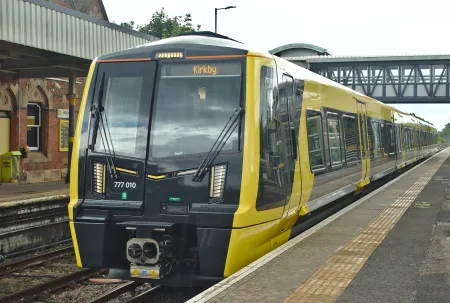
The latest example of pointless virtue-signaling, intended to help ‘save the planet’, has shown itself to be inadequate for its intended role.
The 53 Class 777 units, built by Stadler Rail in Switzerland & Poland (because all the British locomotive manufacturers have long since gone out of business from lack of orders), costing £500 million each, are intended to be used in Liverpool and surrounding parts of Cheshire and Lancashire.
They can operate from the ‘third-rail’ system at 750vdc, which is an extra electrified line running alongside the track, or can be powered through pantographs on the roof at 25kv, though there is no overhead catenary installed, nor any current plans for such a system to be built.
Their third source of power is from onboard batteries, which it is intended will be used outside the current Merseyrail system.
To accommodate the new Class 777 fleet, extensive, and expensive, infrastructure changes were necessitated. These adaptations were performed under a rolling program between October 2018 and May 2019; changes included adjustments to 97 platforms at 56 stations across the Merseyrail network, along with track realignments and other unnamed ‘refinements’.
In October, a new station, costing no less than £80million, was opened at Headbolt Lane to serve the battery-powered trains.
Another cause for the alterations was the increased length of the new units, which was addressed via a mixture of platform lengthening and signal repositioning where required. The program was structured to minimize disruption to Merseyrail’s scheduled services wherever possible.
New power supply transformers had to be installed, along with eight new substations and miscellaneous cable upgrades, to provide greater quantities of electricity.
The first units were delivered for testing in January 2020, and have had to undergo numerous modifications due to problems encountered. Passenger services with the class commenced on 23rd January 2023, initially using unit 777049.
By July 2023, only a handful of units were in service, because of ongoing ‘technical issues’.
The Class 777 units weigh 99 tons each, compared to 36 tons for the 750vdc Class 507 & 508s they are intended to replace. This will of course increase track wear, which will require more frequent maintenance, with increased costs.
Running on 750vdc, they produce 2000hp, and the batteries are configured to produce the same output, for all of 34 miles before they require a full recharge.
Fast-forward to yesterday and the BBC ran an article saying continuing problems with these units have caused cancellation of services, and refunds are having to be made to passengers.
Liverpool City Region mayor Steve Rotherham said:
“We anticipated that we would encounter some teething issues and disruption during the delivery of our new station and trains, but I’ll be the first to say that services on the Kirkby line have fallen short of the standards that our passengers deserve.
While I cannot undo the disruption that passengers have already faced, I hope this gesture demonstrates our appreciation for their patience and understanding.”
He said it was a “gesture of goodwill” for the “teething issues”.
They are still having ‘teething issues’ after three years? Sounds to me more like fundamental design or performance issues.
See the BBC article here bbc.co.uk
But it doesn’t end there. There are two other examples of this kind of nonsense being pursued.
The Severn Valley Heritage Railway has teamed up with the University of Birmingham and local start-up company, Vanguard Sustainable Transport Solutions, to convert a Class 08 diesel shunter to work on hydrogen.
They have removed the existing diesel engine and generators, as they prepare Class 08 shunter No 08635 to receive its new power system.

Image: Severn Valley Railway
Mike Ball, the Severn Valley Railway’s vice chairman, has been closely involved with the project from its inception:
“We were delighted when the University of Birmingham asked us to get involved in this project. As a heritage railway, we’re actively looking for ways to reduce our carbon footprint, and having a hydrogen-powered shunter will play a key part in that plan.
The current preparation stage for the Harrier shunter is providing an excellent opportunity for some of our younger volunteers to put their skills to good use.
The group working on the 08 are all still in their teens, and their ability to plan and implement this task has been nothing short of amazing.
They’re the volunteers of the future, working on a locomotive for the future.”
The best way to ‘reduce your carbon footprint’ Mr Ball, is to stop running services and close down the Severn Valley Railway. Not that I would wish that for a moment, but I have been heavily involved with heritage railways since 1994, and the last thing I want to see is these lines closing down because of non-existent environmental concerns.
Vanguard Sustainable Transport Solutions is designing the hydrogen-battery hybrid traction system. This will be made up of hydrogen cylinders, a hydrogen fuel cell stack, and a hybrid battery.
The cylinders will store hydrogen as a pressurized gas, which will be fed to the fuel cell stack via a regulator. In the fuel cell stack, hydrogen will be combined with oxygen from the air, to produce electricity to power the locomotive.
Sounds like an explosion waiting to happen.
Meanwhile, the battery will store energy to provide additional power for when it’s needed.
The equipment will be mounted on a sub-frame, fitted to the existing engine mountings. It will supply the existing traction motors of the Class 08, which will keep its existing controls.
The Birmingham University article can be seen here at birmingham.ac.uk
Then there is another group, who have gutted a 100-ton former Class 37 freight locomotive, to turn it into a near-silent battery-powered loco.
Owned by the Heavy Tractor Group (tractor is one of the nicknames for the class), 37207 has been converted to run on batteries following three years of research and development by a company called Meteor Power.

Image: PressReader
Throughout last summer, 37207, a former regular on Cornish China Clay services, was used to test an electric powertrain that Meteor Power had installed in a Class 08 diesel shunter and is now ready to receive its electric conversion.
As part of its test program, last June it successfully traveled 1½ miles within Wolverton Works on battery power.
A whole one-and-a-half miles! Wow!!
According to Meteor Power, this development of a battery conversion system for the locomotive provides a “greener, cheaper, and quieter solution for freight or ‘super shunter’ work”.
No details were provided on how much horsepower this loco would develop, nor anything about its range.
The Rail Advent website said in April last year it was hoped that 37207 would be certified to run on the mainline by the end of the year, but I’ve seen no updates since then.
See the Rail Advent article here railadvent.co.uk
These seem just the latest in a series of completely pointless wastes of money, which will do nothing except provide the public and industry with vastly inferior services.



